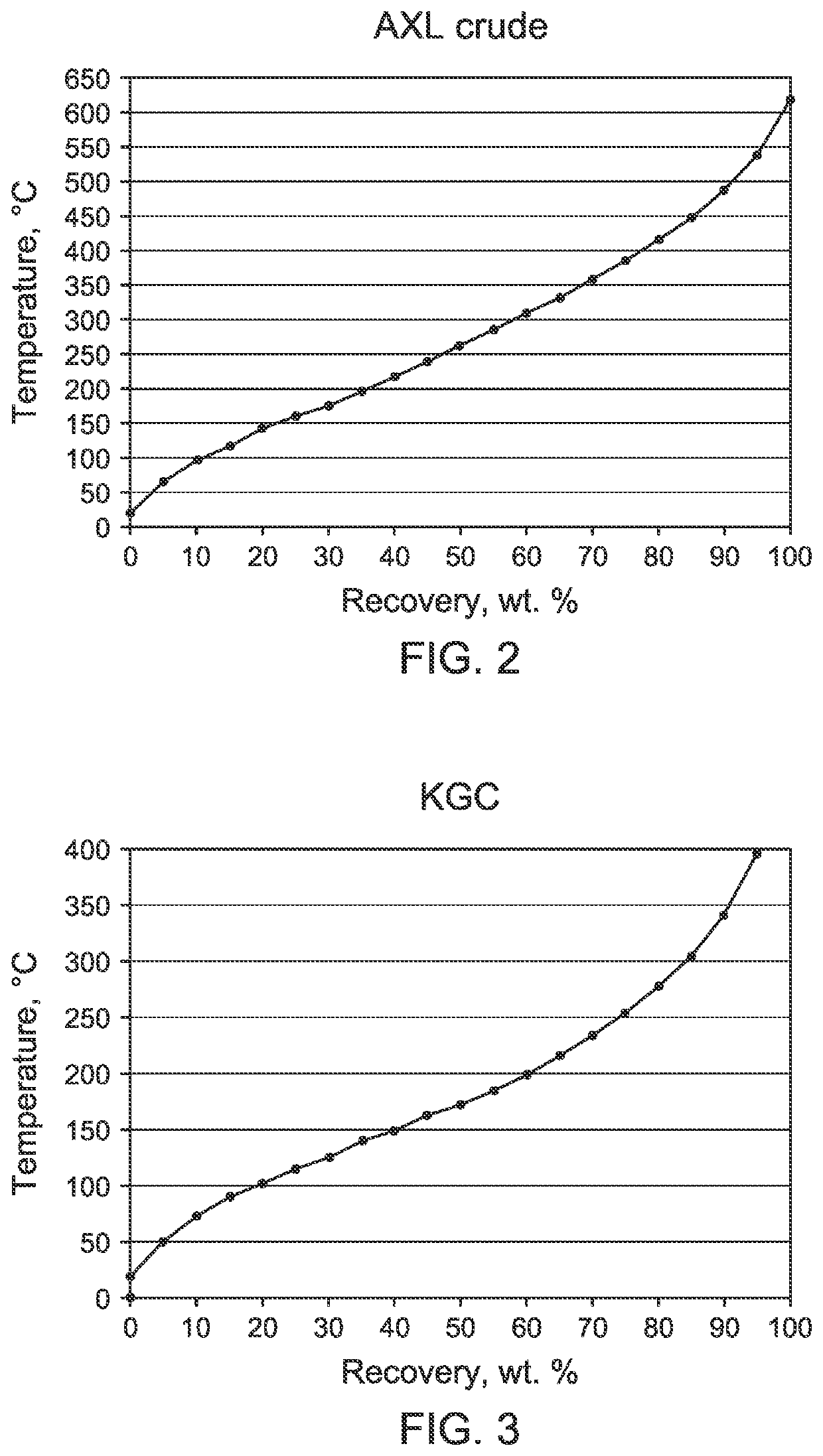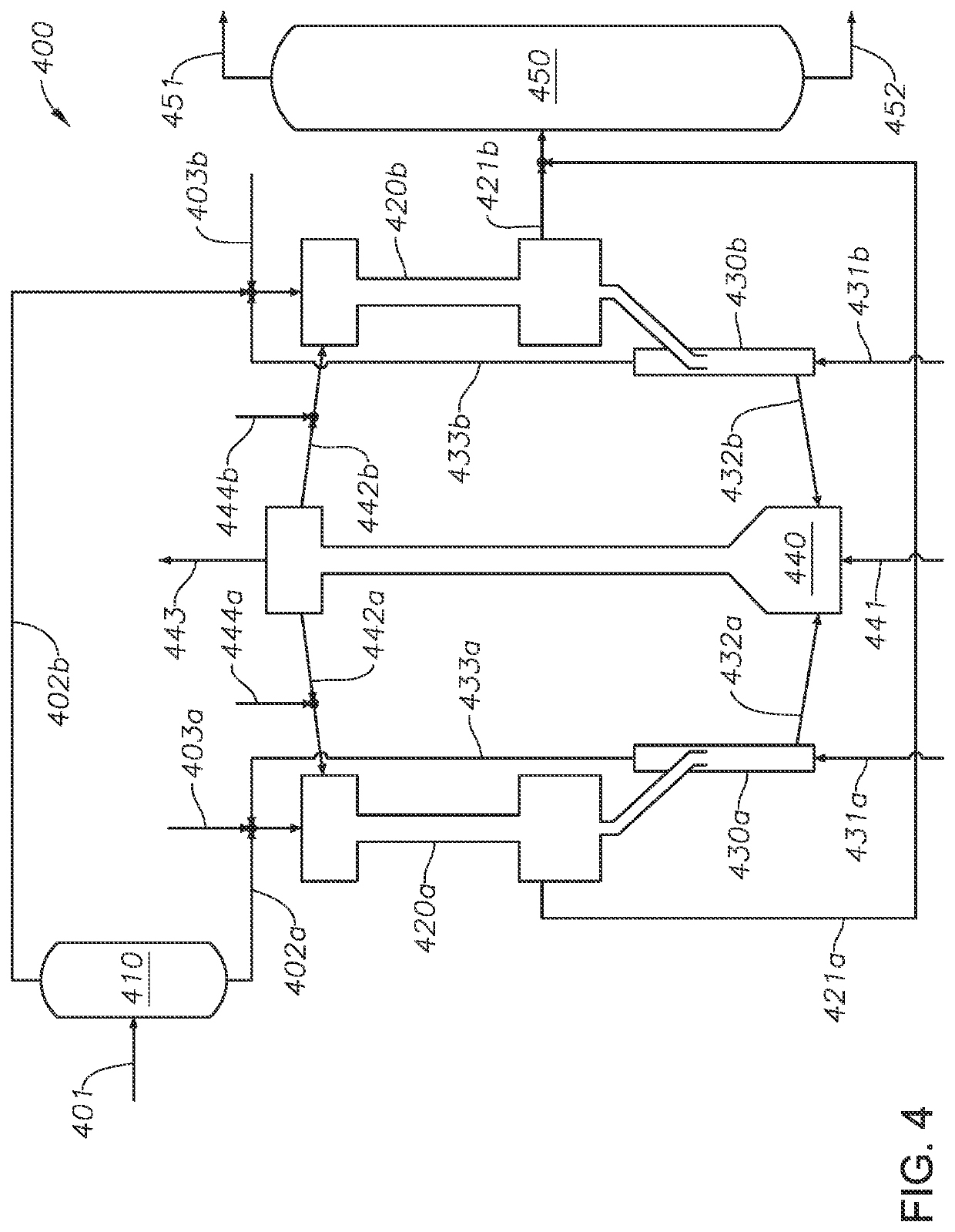Steam-enhanced catalytic cracking of hydrocarbons to produce light olefins
a technology of hydrocarbon cracking and steam-enhanced catalytic cracking, which is applied in the direction of catalytic cracking, hydrocarbon oil treatment, molecular sieve catalysts, etc., can solve the problem of limited use of these cracking methods
- Summary
- Abstract
- Description
- Claims
- Application Information
AI Technical Summary
Benefits of technology
Problems solved by technology
Method used
Image
Examples
example 1
anced Catalytic Cracking of Khuff Gas Condensate
[0058]Khuff gas condensate was processed in three test runs (Test run 1, Test run 2, and Test run 3) using a fixed bed reactor at a temperature of 675° C. Test run 1 was carried out using steam without a catalyst. Test run 2 was carried out using a mixture of 75 wt % commercial equilibrium catalyst (i.e., a mixture of regenerated FCC catalyst and makeup FCC catalyst; referred to as “Ecat”) and 25 wt % modified catalyst. Test run 3 was carried out using steam with a steam-to-feed weight ratio of about 0.5 and the same catalyst mixture used in Test run 2. The modified catalyst was a ZSM-5 catalyst impregnated with metal oxides and about 11.6 wt % phosphorus pentoxide, and sold under the trademark OlefinsUltra®. The modified catalyst contained disodium oxide (Na2O; 0.17 wt %), magnesium oxide (MgO; 0.06 wt %), calcium oxide (CaO; 0.07 wt %), iron(III) oxide (Fe2O3; 0.59 wt %), lanthanum(III) oxide (La2O3; 0.03 wt %), and phosphorus pentox...
example 2
anced Catalytic Cracking of AXL Whole Crude Oil
[0060]Arabian extra light whole crude oil was processed in three test runs (Test run 4, Test run 5, and Test run 6) using a fixed bed reactor at a temperature of about 675° C. Test run 4 was carried out using thermal cracking without a catalyst or steam. Test run 5 was carried out using a mixture of 75 wt % commercial Ecat and 25 wt % modified catalyst. Test run 6 was carried out using steam with a weight ratio of steam to feed of 0.5, and the same catalyst mixture used in Test run 5. The modified catalyst was a ZSM-5 catalyst impregnated with metal oxides and about 11.6 wt % phosphorus pentoxide, and sold under the tradename OlefinsUltra®). The modified catalyst contained disodium oxide (Na2O; 0.17 wt %), magnesium oxide (MgO; 0.06 wt %), calcium oxide (CaO; 0.07 wt %), iron(III) oxide (Fe2O3; 0.59 wt %), lanthanum(III) oxide (La2O3; 0.03 wt %), and phosphorus pentoxide (P2O5; 11.6 wt %). The residence time of the AXL whole crude oil i...
example 3
g AXL Whole Crude Oil in a Dual Downflow FCC Reactor Configuration with and without a Modified Catalyst
[0064]Arabian extra light whole crude oil was processed in a dual downflow FCC reactor configuration according to the process shown and described in FIG. 5. The AXL whole crude oil was first separated in a flash drum to obtain a heavy hydrocarbon feed having a boiling temperature range greater than 350° C. and a light hydrocarbon feed having a boiling temperature range less than 350° C. The light and heavy hydrocarbon feeds were preheated and fed to first and second downflow FCC reactors respectively, which were both operated at 675° C. with a steam-to-feed weight ratio of 0.5. Test run 11 was carried out using only Ecat in both reactors. Test run 12 was carried out using a mixture of 75 wt % commercial Ecat and 25 wt % modified catalyst in both reactors. The modified catalyst had the same composition as the modified catalyst used in Example 2.
TABLE 5Yield comparison for steam-enha...
PUM
| Property | Measurement | Unit |
|---|---|---|
| mass ratio | aaaaa | aaaaa |
| cracking temperature | aaaaa | aaaaa |
| cracking temperature | aaaaa | aaaaa |
Abstract
Description
Claims
Application Information
 Login to view more
Login to view more - R&D Engineer
- R&D Manager
- IP Professional
- Industry Leading Data Capabilities
- Powerful AI technology
- Patent DNA Extraction
Browse by: Latest US Patents, China's latest patents, Technical Efficacy Thesaurus, Application Domain, Technology Topic.
© 2024 PatSnap. All rights reserved.Legal|Privacy policy|Modern Slavery Act Transparency Statement|Sitemap



